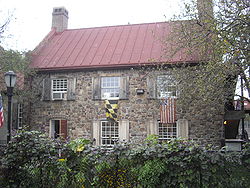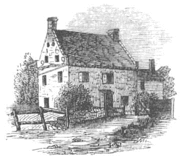- Old Stone House (Brooklyn, New York)
-
Old Stone House Established 1934 Location Brooklyn, New York, USA Website http://www.theoldstonehouse.org For other uses, see Old Stone House (disambiguation).The Old Stone House is a 1930 reconstruction--with some original materials--of the Vechte-Cortelyou House, which was destroyed in 1897. The house is located in Brooklyn, New York City, in the Park Slope neighborhood at Fifth Avenue between Third and Fourth Streets along where Gowanus Creek used to run.
Contents
Location
Today, one of the branches of the Gowanus Canal ends several hundred feet away from the house, near Third Avenue between Third and Sixth streets.
History
The Old Stone House is a replica, using some unearthed original materials, of a Dutch stone farmhouse originally built adjacent to the current site by the Dutch immigrant Claes Arentson Vechte in 1699. It is also known as the Vechte-Cortelyou House. The Vechte family farmed the lands around the house, harvested oysters in the Gowanus Creek and ferried their produce down the creek to the Gowanus Bay and thence to lower Manhattan. The farmhouse built of brick and stone is the site of the present day J.J. Byrne Memorial Park (formerly Washington Park) which is near the site of one of the major clashes of the Battle of Long Island (also known as the Battle of Brooklyn).
Battle of Brooklyn
The house was an important location in the Battle of Brooklyn during the American Revolutionary War - the first major engagement of the Continental Army after the Declaration of Independence, and the largest battle of the entire war. On August 27, 1776, the house was used as an artillery position by an estimated 2,000 British and hired Hessian soldiers who fired on the Americans, who had already suffered disastrous losses and were fleeing from the east to the American forts across the Gowanus Creek to the west. Some four hundred soldiers of the Maryland Brigade under Colonel William Smallwood regained the house twice that day, but were finally repulsed by the British, with very heavy casualties. General George Washington, viewing the particularly fierce fighting at the Old Stone House from his vantage point atop a hill near the west end of present-day Atlantic Avenue, was famously reported to have emotionally exclaimed: "What brave men I must this day lose!"[1][2]
Nicholas Vechte, grandson of Claes, lived in the Old Stone House during the American Revolutionary War under the British occupation. Upon his death in 1779, the farm he willed to his grandson, Nicholas R. Cowenhoven. In 1797, Cowenhoven sold the house to Jacques Cortelyou, who purchased it for the use of his newly married son, Peter. Peter's son Jacques inherited the house in 1815. His family was the last to live in the Old Stone House.
After the death of his wife Jacques Cortelyou sold the property to Edwin Litchfield, a railroad developer, in 1852. Litchfield lived in a mansion that is currently in Prospect Park. Litchfield Villa is the Brooklyn headquarters of the New York City Department of Parks and Recreation. Litchfield was the major landowner of the farmland in the area at that time and sold much of his land to the city for the creation of Prospect Park.
Baseball clubhouse
After the Litchfield purchase The Old Stone House remained standing another forty years and was occupied by a caretaker during that period. It also served as a club house for the professional baseball team called the Brooklyn Superbas, which would later be known as the Brooklyn Dodgers before their move to Ebbets Field. The Old Stone House was across the street from Washington Park, one of the oldest professional-baseball stadiums in New York. A wall from Washington Park is still visible on Third Avenue between First and Third Streets.
Museum
The land that the house was on was purchased by the New York City Parks Department in 1923 and the house, which had been razed and burned in 1897, was excavated in 1930. Half of the house was below street level when the level of Fourth Avenue had been graded up at the end of the nineteenth century. The house was reconstructed in 1934 using many of the original stones, though it was moved slightly from its original location. It underwent additional restoration in the 1970s and 1990s.
Today the Old Stone House Historic Interpretive Center is operated by the Old Stone House of Brooklyn (OSH), a not-for-profit corporation, under license from the New York City Department of Parks & Recreation. In addition to an exhibit on the battle, OSH offers a full program of school visits on subjects related to the history of the house and the battle and an extensive schedules of concerts, readings, lectures and other events.[3]
References
- ^ Schecter, Barnet. The Battle for New York: The City at the Heart of the American Revolution. Walker & Company. New York. October 2002. ISBN 0-8027-1374-2
- ^ McCullough, David. 1776. Simon & Schuster. New York. May 24, 2005. ISBN 978-0743226714
- ^ http://www.theoldstonehouse.org
External links
Coordinates: 40°40′23″N 73°59′05″W / 40.6729583°N 73.984625°W
Categories:- History of New York City
- American Revolutionary War
- New York in the American Revolution
- Museums in Brooklyn
- Historic house museums in New York
- American Revolutionary War museums in New York
- Houses in Brooklyn
Wikimedia Foundation. 2010.



